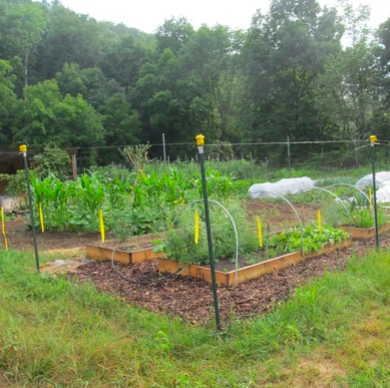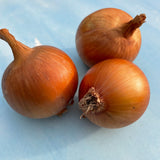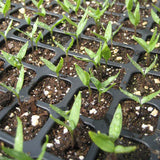
Edible Lesson Plan
 School begins at the peak of fall harvest season and ends right as the spring growing season is kicking off, making school garden planning a bit more more challenging than traditional garden planning. However, there are a lot of options of vegetables and herbs that can be grown within the traditional school season parameters. Some things can be planted early spring and harvested a few weeks later, others can be planted in the spring and harvested in the fall, and some can be planted late summer/early fall for fall and winter harvesting. All our recommendations, are easy to grow, with an emphasis on FUN.
School begins at the peak of fall harvest season and ends right as the spring growing season is kicking off, making school garden planning a bit more more challenging than traditional garden planning. However, there are a lot of options of vegetables and herbs that can be grown within the traditional school season parameters. Some things can be planted early spring and harvested a few weeks later, others can be planted in the spring and harvested in the fall, and some can be planted late summer/early fall for fall and winter harvesting. All our recommendations, are easy to grow, with an emphasis on FUN.
(If you have successfully run a school garden, or have questions, please post any questions or comments below. We'd love to get a discussion going!)
Plant in Spring, Harvest in Spring: Your students will be gratified with their efforts early with these quick varieties. The key is to get them sown asap!
1. Spring radishes are quick, easy and crunchy. Easter Egg Radish is a top choice. It has a great name, and the colors are bright and fun. French Breakfast is also a unique choice, the pink roots are oblong and have white tips.
2. Bloomsdale Spinach can be sown as soon as the snow melts (or even sooner in late in the fall) for spring harvest. Despite the popular stereotype as being disliked by kids, the mild flavor and succulent texture of fresh spinach is a hit with eaters of all ages.
3. Like spinach, Mache can be sown late fall or early spring and comes up quick. The cute little heads might new and exciting for many students. The flavor is sweet and mild.
4. Peas are a much loved spring crop, but depending on your school year, you might miss the harvest! Sugar Daddy Snap Pea and Laxton's Progress Shelling Pea are shorter vines with fewer days to maturity. Tom Thumb is a great choice for growing in class rooms in containers. If it seems the school year might end before the peas arrive, there is nothing wrong with eating the tendrils. Just snip the growing tips.
5. Lettuce can be started in doors, then transplanted outside and produce heads by the end of the school year, or, it can be directly sown in the spring and cut as a baby leaf 3-4 weeks later. A favorite among kids is Spotted Trout, the name is simply irresistible to the imagination! Little Gem produces small, compact heads quickly. Ultimate Salad Bowl has lettuces, Asian greens and other yummy varieties that are fun for kids to observe, pick out and taste.
6. When they grow it themselves, many kids are ravenous for kale, especially Dino Kale. Let them munch on the scaly leaves like herbaceous beasts in the spring. If you have someone to tend the garden while school is out, leave the kale plants in the ground for the fall season, and the munching can repeat!
7. Beets are a real treat--there is nothing quite as satisfying than pulling a round fat one out of the ground! Brilliant Beet Blend has a fun diversity of color, Chioggia will thrill with its bullseye pattern, and Early Wonder Tall Top is a reliable early leafy beet with fat red roots.
8. Bush beans are so easy to grow. They take about 50 days from seeding to harvest. Get them in the ground asap after the threat of frost has passed and you might get a harvest in before school ends. Our top picks for school gardens are Dragon's Tongue Bean, a flat white snap bean with fiery purple speckles, and Provider, a reliable green snap bean.
9. Herbs are fun and flavorful. If sown early, some can be cut when young, such as: Cilantro, Mammoth Dill, Italian Large Leaf Basil and Gigante d'Italia Parsely. If you are interested in a little seed-saving education, all these herbs can all be left in ground. Most will flower and produce seeds just in time for the following school year. (Parsley is a biennial and will produce seeds the following year.)
Plant in Spring, Harvest in Fall: The timing works out perfectly for some crops to be planted in the late spring and harvested in the fall, when the next school season begins. This works well in school garden situations where there is someone available to tend the garden in the summer months.
 1. What could be more fun than growing popcorn? Perhaps growing multi-colored Calico Popcorn!
1. What could be more fun than growing popcorn? Perhaps growing multi-colored Calico Popcorn!
2. Aunt Molly's Ground Cherry is a fun little fruit that is covered by a husk. It is sweet and crunchy, a favored snack among kids. Ground cherries can be started in pots, then transplanted out doors. In the late summer when school starts up, there should be copious amounts of husk cherries.
3. Winter squash and pumpkins require minimal care during the summer. Big Max is a huge, ornamental jack 'o' lantern type, while Long Island Cheese Pumpkin will feed many with its huge cheese wheel shaped fruits.
4. Tomatoes and peppers are a great choice if you have the resources to start them early and care for them while school is out for the summer. Peak tomato season is generally late August, so transplant tomato plants about two weeks late for a nice flush towards the beginning of the school year. Isis Candy Shop Cherry Tomato will delight students with its diversity of shapes, sizes and colors. Doe Hill Sweet Peppers are sweet and petite, a great choice for smaller spaces.
5. Variegated Nasturtiums are a fun flower that brightens any space. They are great in the school garden because eating the peppery flowers is a thrill to the uninitiated.
6. Skyscraper Sunflowers are unimaginably tall, produces fat heads with lots of edible seeds.
Plant Late Summer, Harvest in Fall: The planting season doesn't have to end in the spring! There are a few limited crops that can be sown late summer and enjoyed in the fall. If you have season extension resources, such as hoops and row cover, or a greenhouse, you have a longer harvest window. Check out our this fall planting guide for tips on how to plan for fall gardens.






